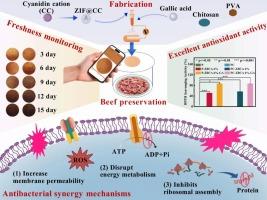静电纺聚乙烯醇/chitosan-ZIF-8@cyanidin阳离子-没食子酸多功能纳米膜用于牛肉新鲜度的实时可视化监测
IF 13.2
1区 工程技术
Q1 ENGINEERING, CHEMICAL
引用次数: 0
摘要
在复杂的食品系统中,单一功能的薄膜往往难以同时达到有效的新鲜度指示和保存。本研究采用“稳定指标-抗菌-抗氧化”综合策略,开发了一种ph响应多功能膜。首先,将不稳定氰化物阳离子(CC)负载到沸石咪唑酸框架-8 (ZIF-8)中。然后,将负载zif -8的CC (ZIF-8@CC)与没食子酸(GA)结合,通过静电纺丝将其掺入聚乙烯醇(PVA)和壳聚糖(CS)基质中。对该多功能膜的形态、pH响应、抗菌抗氧化性能和生物相容性进行了表征,并将其应用于牛肉保鲜。结果表明,CS和ZIF-8@CC的掺入显著提高了膜的疏水性和机械强度。该膜具有广谱的pH响应行为,在1 ~ 12的pH范围内颜色由粉红色逐渐变为棕色,对NH₃·H₂O具有较高的敏感性,并且具有良好的颜色稳定性。抑菌试验表明,ZIF-8/Zn2+对常见食源性致病菌的抑制率超过95%,全基因组转录组分析揭示了ZIF-8/Zn2+、CS和GA之间的协同抑菌机制。同时,该膜还表现出优异的抗氧化性能,自由基清除率超过86%。应用于牛肉保鲜时,不仅可以通过颜色变化直观地显示腐败过程,而且可以延长3-4天的保质期。此外,通过集成智能手机RGB分析技术,实现了牛肉新鲜度的实时定量监测。该研究为开发多功能智能包装薄膜提供了一种新的策略,在生鲜食品质量监控方面具有潜在的应用前景。本文章由计算机程序翻译,如有差异,请以英文原文为准。

Electrospun polyvinyl alcohol/chitosan-ZIF-8@cyanidin cation-gallic acid multifunctional nanofilm for real-time visual monitoring of beef freshness
In complex food systems, single-functional films often struggle to simultaneously achieve effective freshness indication and preservation. This study developed a pH-responsive multifunctional film using an integrated “stable indicator–antibacterial–antioxidant–indication” strategy. First, unstable cyanidin cation (CC) was loaded into zeolitic imidazolate framework-8 (ZIF-8). Then, ZIF-8-loaded CC (ZIF-8@CC) was combined with gallic acid (GA) and incorporated into a polyvinyl alcohol (PVA) and chitosan (CS) matrix via electrospinning. The multifunctional film was characterized for its morphology, pH response, antibacterial and antioxidant properties, and biocompatibility, then applied in beef preservation. The results showed that the incorporation of CS and ZIF-8@CC significantly improved the hydrophobicity and mechanical strength of the film. The film exhibited broad-spectrum pH-responsive behavior, with color gradually changing from pink to brown within the pH range of 1–12, and high sensitivity toward NH₃·H₂O, along with good color stability. Antibacterial tests demonstrated an inhibition rate of over 95% against common foodborne pathogens, and whole-genome transcriptome analysis revealed the synergistic antibacterial mechanism among ZIF-8/Zn2+, CS, and GA. Meanwhile, the film also exhibited excellent antioxidant performance, with a free radical scavenging rate exceeding 86%. When applied in beef preservation, the film not only visually indicated the spoilage process through color changes but also extended the shelf life by 3–4 days. Furthermore, by integrating smartphone RGB analysis technology, real-time and quantitative monitoring of beef freshness was achieved. This study provides a new strategy for developing multifunctional films for intelligent packaging, with potential applications in quality monitoring of fresh foods.
求助全文
通过发布文献求助,成功后即可免费获取论文全文。
去求助
来源期刊

Chemical Engineering Journal
工程技术-工程:化工
CiteScore
21.70
自引率
9.30%
发文量
6781
审稿时长
2.4 months
期刊介绍:
The Chemical Engineering Journal is an international research journal that invites contributions of original and novel fundamental research. It aims to provide an international platform for presenting original fundamental research, interpretative reviews, and discussions on new developments in chemical engineering. The journal welcomes papers that describe novel theory and its practical application, as well as those that demonstrate the transfer of techniques from other disciplines. It also welcomes reports on carefully conducted experimental work that is soundly interpreted. The main focus of the journal is on original and rigorous research results that have broad significance. The Catalysis section within the Chemical Engineering Journal focuses specifically on Experimental and Theoretical studies in the fields of heterogeneous catalysis, molecular catalysis, and biocatalysis. These studies have industrial impact on various sectors such as chemicals, energy, materials, foods, healthcare, and environmental protection.
 求助内容:
求助内容: 应助结果提醒方式:
应助结果提醒方式:


